Loading AI tools
1920s British piston aircraft engine From Wikipedia, the free encyclopedia
The ADC Cirrus is a series of British aero engines manufactured using surplus Renault parts by the Aircraft Disposal Company (ADC) in the 1920s.
| Cirrus | |
|---|---|
 | |
| ADC Cirrus II at the Science Museum, London | |
| Type | Air-cooled 4-cylinder inline piston engine |
| National origin | United Kingdom |
| Manufacturer | Aircraft Disposal Company (ADC) |
| First run | 1925 |
| Major applications | de Havilland DH.60 Moth Avro Avian |
The engines were air-cooled, four-cylinder inline types. They were widely used for private and light aircraft.
The Cirrus engine originated in Geoffrey de Havilland's 1924 search for a powerplant suitable for the light two-seat sports biplane which would become the de Havilland Moth. No engine existed at the time with a suitable level of power combined with a low weight. The Aircraft Disposal Company, also known as Airdisco and ADC, were producing the low-cost Airdisco V8 which had been developed by Frank Halford from their large stocks of war surplus Renault V8 aero engines. De Havilland realised that half of this engine would make an air-cooled four-cylinder inline engine of just the right size at low cost. He persuaded Halford to undertake its design and development.
The cylinders, pistons, con-rods and gearing were taken from the Renault, with the valve gear based on the Airdisco, and a new five-bearing crankshaft and cast crankcase were designed.[1] It became the first Cirrus engine, and the first air-cooled four-cylinder inline aero engine to go into quantity production.
The original Cirrus engines were all designed by Halford and built by ADC. The 65 horsepower (48 kW) Cirrus I passed its 50-hour type rating in 1925. De Havilland launched his product as the Cirrus Moth and it proved a winning combination. The engine was soon adopted for other aircraft. Later versions named the Cirrus II, and Cirrus III were produced, each with slightly greater displacement and power (Cirrus II - 85 hp, Cirrus III - 90 hp).[2][3]
ADC ceased manufacture when it ran out of surplus Renault engines around 1928.
When ADC ran out of parts, manufacture of the Cirrus III was taken up by Cirrus Aero Engines, also based at Croydon.
The Cirrus III was also adapted and improved by American Cirrus Engines, who manufactured it under license.[4][5]

List from Lumsden[6] except where noted. The list includes trial installations where a different engine was principally adopted.

Data from Lumsden.[8]
Comparable engines
Related lists
Seamless Wikipedia browsing. On steroids.
Every time you click a link to Wikipedia, Wiktionary or Wikiquote in your browser's search results, it will show the modern Wikiwand interface.
Wikiwand extension is a five stars, simple, with minimum permission required to keep your browsing private, safe and transparent.